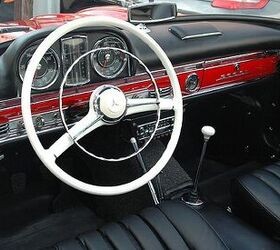Summer 2005 – my vintage car rally vacation plans hit a major roadblock. Engine trouble with another project car unexpectedly drained the funds, turning my dream trip into a garage nightmare. Just as disappointment settled in, a phone call offered a lifeline: the chance to co-drive in an event featuring what many consider the world’s first supercar – the Mercedes-Benz 300SL. An offer accepted faster than a Formula One pit stop.
The 300SL began life as a race car, ingeniously adapted for the road. This vision came from Max Hoffman, Daimler-Benz’s U.S. importer, who persuaded Stuttgart to create a street-legal version of their formidable W194 race chassis for affluent American buyers. The 1954 New York Motor Show witnessed the unveiling of Mercedes’ claim to the “world’s fastest production car”. Its most captivating feature? Doors hinged at the roof, creating a silhouette so distinctive that the 300SL earned and retains the legendary nickname, “Gullwing Mercedes.” An automotive icon instantly recognizable worldwide. Interestingly, the 300SL Roadster, the drop-top variant, often flies under the radar, appearing merely as a “nice old Mercedes” to the untrained eye, lacking the visual drama of those famous doors.
 Mercedes Benz 300SL Roadster in silver, parked outdoors, showcasing its classic design and open top
Mercedes Benz 300SL Roadster in silver, parked outdoors, showcasing its classic design and open top
Beyond its striking aesthetics, the 300SL pioneered automotive technology with Direkteinspritzung mit mechanisch geregelter Einspritzpumpe, or direct mechanical fuel injection. Otherwise, the 300SL’s engineering was characteristically Teutonic in its robustness rather than outright flamboyance. It featured the dependable 3.0-liter straight-six engine common across the Mercedes-Benz range of that era, recirculating ball steering, swing axle rear suspension, and drum brakes on all wheels. Despite this relatively conventional mechanical setup, the 300SL commanded a staggering $11,000 in 1954 – a price point that restricted ownership to the wealthiest echelons of society. For the price of one 300SL, you could acquire four Jaguar cars and a Corvette, a financial ratio that, remarkably, has persisted over time.
Mercedes produced 1,400 of the iconic “Gullwing” coupes. Some found their way to “gentleman racers” who specified performance enhancements like Rudge knock-off wheels, lightweight aluminum body panels, and higher-output engines. In 1957, the coupe’s production ceased, making way for the introduction of the 300SL Roadster. The Roadster came standard with the uprated engine and Mercedes engineers refined the rear suspension by lowering the swing axle pivot point. This significantly tamed the Gullwing’s notorious tendency for snap oversteer in sharp corners, enhancing the Roadster’s handling. Mercedes manufactured approximately 1,858 Roadsters, bringing the total 300SL production run to 3,258 vehicles over eight years.
The 1957 Mercedes-Benz 300SL Roadster I had the privilege to drive exemplified the marque’s engineering prowess of its time. Its handling is impressive for a car designed in the mid-1950s. Having experienced both a 300SL and a Jaguar XK120, the Mercedes demonstrably outperforms the Jaguar in terms of overall driving dynamics. While the straight-eight powered 300SLR race cars battled and often bested the C-type Jaguars on the track despite having less torque, the 300SL road car’s inline-six engine, while potent, doesn’t deliver the raw torque of the XK Jaguar’s larger engine. However, it compensates with superior horsepower. With a driver who is both willing and highly attentive, the 300SL Roadster delivers an engaging and rewarding driving experience.
The 300SL Roadster maintains a hushed demeanor at cruising speeds, transforming into a snarling beast above 4000 rpm. The inline-six unleashes a thrilling roar, punctuated by the mechanical staccato of the fuel injection system. The gearbox, with its ratios optimized for track or autobahn use in 4th gear, means that at typical US road speeds, the engine revs low and lacks immediate low-end torque for quick overtaking. To extract peak performance, high revs and considered driving are essential. The particular car I drove exhibited a synchro issue in third gear, necessitating double-clutching and precise throttle control to achieve smooth downshifts, avoiding any resemblance to a Stirling Moss-esque gearbox mishap. Overtaking required planning and anticipation. Nevertheless, these minor mechanical quirks do little to diminish the overall experience.
In terms of comfort, ergonomics, build quality, fit, finish, and the overall driving experience, the 300SL Roadster surpasses even contemporary Jaguar sports cars. The classic Mercedes is remarkably refined and ergonomically well-designed, with exceptional engineering evident in every detail. Apart from the use of hard-wearing, durable materials (absent of any plastic), the 300SL feels remarkably “modern.” Unlike some modern performance cars, the 300SL comfortably accommodates drivers of varying statures. The weatherproof convertible top is ingeniously designed, easily raised or lowered and stowing neatly beneath a beautifully crafted cover. Coupe versions are often cited as less comfortable than the roadsters due to less effective cabin ventilation.
While a 300SL Roadster is certainly capable of participating in vintage track days and rally events, its true essence lies in its ability to transport well-heeled owners to glamorous social engagements in impeccable style. The Mercedes-Benz 300SL Roadster is the embodiment of sporting elegance, a timeless classic that continues to captivate enthusiasts and collectors worldwide.